Essential Requirements for Bonsai Tree Growth
Bonsai trees, like all other plants, need the following key elements to grow and thrive.
- Water
- Sunlight
- Air
- Temperature
- Soil
- Nutrients
These are all necessary for trees’ survival but a few of them, namely water and nutrients, should be deliberately cut off to make a normal tree into its miniature version: a bonsai.
Water

Water is essential for the growth and survival of bonsai trees. In their growth, water serves the following important functions.
- It acts as a reactant in the process of photosynthesis.
- It forms the primary component of the tree body (50% to 70%).
- It serves as a transportation medium for materials throughout the tree, especially to regions where growth is occurring.
What happens if water is limited?
There are three major upsides to limiting water for bonsai trees;
- It can keep trees small.
- It can produce smaller leaves.
- It can produce shorter internodes.
Maintain small size
If we limit watering and keep bonsai trees in a rather dry condition, they keep their stomata behind their leaves closed to avoid losing moisture through their leaves. This will reduce the amount of carbon dioxide available for photosynthesis and lessens the amount of energy produced.
With less energy, trees’ growth is suppressed, which enables them to keep their small size.
Limiting too much water is, of course, detrimental to your bonsai trees but as keeping their miniature size is one of the most important aspects of bonsai care, giving an abundance of water isn’t good either.
Smaller leaf size
The other reaction to water shortage is having smaller (or fewer) leaves to conserve water.
A bonsai tree should have small leaves to have an appearance of a large tree. There are various ways to make leaves smaller but restraining water is one of its ways, besides cutting fertilizer and putting them in small, shallow pots.
Shorter internodes

Shorter internodes make a bonsai tree look like a bid tree
Nodes are the points on a plant stem where leaves, branches, and flowers emerge. The distance between nodes is known as the internode length. As a bonsai tree, the length of the internodes should be close enough so that the bonsai tree looks like a big tree.
When a tree is experiencing water stress, it will often reduce its internode length in order to conserve energy. Transporting water and nutrients through its body is costly when it is tall and wide. Water shortage allows the tree to produce a smaller, more compact body with shorter internodes, which require less water to maintain.
Having short internodes is very important for bonsai aesthetics because once internodes are elongated, it is almost impossible to shorten them, at least naturally. It is like a human body; once we are grown, we are grown, and unless we go through a surgical operation, we can’t make ourselves small again.
Sunlight

Bonsai trees need sunlight to make their energy through photosynthesis. If there’s no light, they can’t grow.
That said, too much light can hurt the trees, especially ones that grow in the shade. The amount of sunlight they need varies from species to species but in general, bonsai trees prefer full to partial sunlight.
This means most bonsai species cannot grow inside the house without an additional light source.
The amount of light a tree gets also depends on how strong the light is (intensity of light) and how long it shines (duration of light exposure). The intensity and duration of light do not always have the same effect on the tree Just because a tree gets a lot of really bright light for a short time doesn’t mean it’s the same as getting less bright light for a longer time.
Bonsai trees need the right intensity of light for the right period of time.
Air
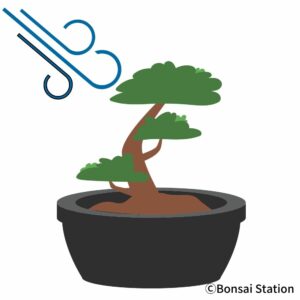
Plants are literally formed “out of thin air”. Besides water, about 98% of their body (dry weight) comes from the atmosphere through photosynthesis with a remaining small portion from the soil.
Carbon dioxide is important for trees as it plays a crucial role in the process of photosynthesis. During photosynthesis, trees use carbon dioxide, water, and sunlight to produce glucose, which is used as a source of energy.
Also, trees also need oxygen for respiration, by which they break down glucose to release energy for their metabolic processes. Just like animals, trees need oxygen to support their cellular respiration and survival.
Temperature
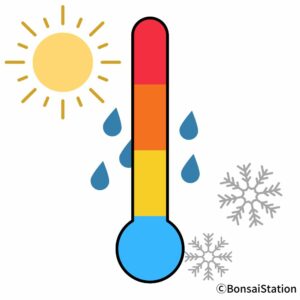
Bonsai trees have specific temperature requirements, with each species having its own optimal temperature range. Different trees survive in different temperature ranges but most tees grow better in temperatures between 32 and 68°F (0° to 20°C).
Extreme temperatures, either too hot or too cold, can limit the growth and survival of trees, partly because they cannot control their body temperature like animals can.
A warmer temperature is better than a cooler temperature for growth but there is a limit to how warm it can get before they start to grow slowly rather than fast. When it is too warm, they start using up more energy for respiration than they can make through photosynthesis.
Soil
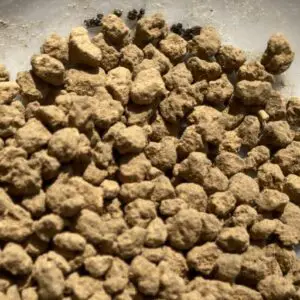
Akadama
Bonsai soil requirements
Soil provides trees with anchorage for roots to stand still as well as water, nutrients, oxygen and warmth. Like all other plants, bonsai trees need water for photosynthesis and oxygen for root respiration, both of which are obtained through soil.
As such, bonsai soil needs good water retention, good drainage, and good aeration. This is all the more important for bonsai trees because their root system is limited in a tiny space and a small imbalance in these qualities can be harmful to their health.
Bonsai soil vs. normal plant soil
Generally speaking, good horticultural soil should contain organic matter, which is deemed the most important factor in improving normal potting soil for plants.
Bonsai soil, however, must contain little or no organic matter but should be able to hold nutrients when we fertilize them. If the soil is rich in nutrients, it will be harder to control the strength of tree growth as the trees grow vigorously.
Nutrients
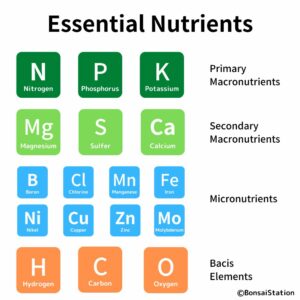
Bonsai trees, like all plants, require specific nutrients to grow and thrive. There are 17 essential nutrients that all plants need to grow, three of which are obtained from air and water.
These essential nutrients include macronutrients such as nitrogen, phosphorus, and potassium, as well as micronutrients such as iron, zinc, and magnesium. They need all of these in a specific balance and too much or too little of some of the elements are generally not good for growth.
What happens if nutrients are limited?
There is one upside to limiting nutrients for bonsai trees: it can keep the tree small. Lack of any of the required nutrients can potentially limit growth.
We want bonsai trees to be healthy but don’t want them to grow big. For this, we need to fertilize enough for them to be sound but not in excess to be used to grow vigorously.
Making energy: photosynthesis for bonsai
What is photosynthesis

Trees use sunlight as well as carbon dioxide and water to create their energy source, glucose (sugar) through photosynthesis. Any part of a tree that is green can perform photosynthesis. The sugar can either be used right away to provide energy to the leaves or it can be transported to the stem and roots, where it is either used or converted to starch for storage.
Photosynthesis is a critical process for all plants, including bonsai trees, as it is the foundation for their growth and health.
Importance of sunlight
Bonsai trees require sunlight to perform photosynthesis, and the amount of light they receive can greatly impact their growth and development. Common bonsai species such as juniper, maple and cherry blossom are photophilic plants; i.e. plants that grow in open places and cannot withstand a long period of time in the shade.
Importance of air
Photophilic plants like bonsai trees need on average 35,000 to 40,000 lux of light density, which is normally attainable only by keeping them outside.
In addition to sunlight, bonsai trees also need carbon dioxide and water to perform photosynthesis. They need a constant supply of new carbon dioxide coming into their growing space. Without moving air, carbon dioxide can be rapidly removed from the surrounding air by photosynthesis.
How energy is used and stored
The energy produced through photosynthesis is used for the growth of roots, stems and branches as well as their maintenance. Fine roots that are responsible for most water and nutrient uptake must be continuously replaced. New shoots must grow each year to produce new leaves, even in coniferous species that do not shed leaves every year.
For deciduous trees, enough sugars must be stored in the roots and stem to maintain the root system over the winter months and to support the spring growth of new leaves.
If growing conditions are favorable, enough sugar is produced for all maintenance,
growth and storage requirements and any additional energy is usually used for additional growth for thickening trunks and branches.
Bonsai Tree Growth Pattern
Types of tree growth
Tree growth occurs in 2 ways:
- growth from the root and shoot tips resulting in increases in height and length (primary growth), and
- growth that increases the thickness of stems and branches (secondary growth).
Shoot growth
Terminal bud
The growth that lengthens the shoot (and root) occurs only in small areas at their tips. In fact, the growth of all leaves, branches and trunks is a result of growth at the tips and not the other parts of trees.
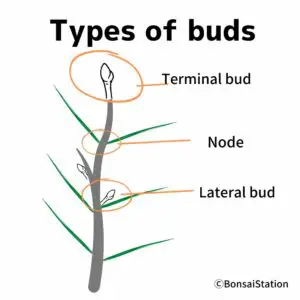
Types of buds
At the tip of the branches, there is a tiny part called the terminal bud. This includes the growing leaves around it. When a tree is young, one of these terminal buds grows straight up, which is called the leader. The terminal bud which is located at the apex of the main stem forms the trunk of the tree over time.
Where each leaf joins the branch, there’s a small part that can become a new terminal bud. This part is called a lateral bud and it can grow into a new branch. These lateral buds stay dormant until new branches are needed.
This is very important to know because branches and trunks tend to grow longer and longer without branching off in the middle if we don’t intervene to stimulate lateral buds to grow into new branches.
As a good bonsai tree has finely ramified branches that grow closely together, pruning, pinching or defoliation have to be done to encourage ramification as a part of the bonsai technique.
Leaf arrangement pattern
Because the buds grow from leaf bases at nodes, the pattern of leaf production at the tips ultimately determines the pattern of branches when trees mature. Leaves develop in one of two arrangements: alternate or opposite. (There are other patterns but these should suffice for bonsai growing.)
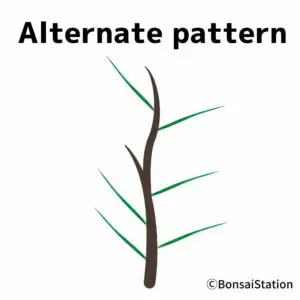
Alternate pattern
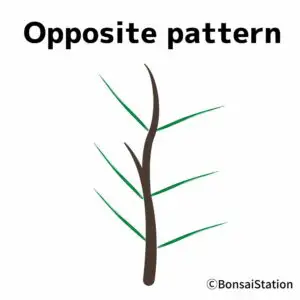
Opposite pattern
With the alternate pattern, leaves are produced one at a time, with one leaf at each
node. With the opposite pattern, leaves are produced two at each node, on opposite sides of the branch.
Each tree species produces leaves in a particular pattern on the stem, alternate or opposite.
If you are growing an opposite pattern tree like Japanese maple, you should prune branches to make it an alternate pattern. Having two branches at the same position enlarges the node and ruins the aesthetic of your tree.
Shoot growth pattern
There are trees whose leaves can be produced at the tips continuously throughout the growing season or have periods of growth and a resting stage. The former with continuous growth is called “sustained growth” or “free growth” and the latter with resting stage is called “preformed growth”.
Sustained growth
Trees with sustained or free growth, such as maples and willows, stop only when weather conditions are unfavorable. They grow when buds contain shoots with some preformed leaves but are also capable of forming additional leaves during the growing season.
When pruned, pinched or defoliated, the latent buds are stimulated to grow, resulting in the development of new shoots from the branches.
Broadly speaking, deciduous trees tend to fall into this category.
Preformed growth
Trees with preformed growth, on the other hand, grow only once in the growing season when the bud at the end of each branch opens and the leaves mature. They then appear to stop growing. Some of these preformed growers are capable of a second flush of growth in one season if the growing conditions are favorable, but usually, it’s not the case.
For preformed growers, this year’s buds are already formed in the previous year, the number of which is determined by that year’s environmental conditions. So, it is very difficult to manipulate the trees to sprout again by pruning, etc. at least this year for those with this growth pattern.
In other words, pre-formed growers are not easy for back-budding; trimming the tip of the branch does not encourage new buds to break out. This is because the ability of a plant to back-bud is largely determined by its genetic makeup, specifically the presence of dormant buds.
As I said earlier, species with preformed growth patterns have a predetermined number of buds in the terminal bud and once they opened and formed shoots for the year, there are generally no additional dormant buds that can open during the same growing season.
Trees with preformed growth patterns include a large part of conifers like pines and spruces, and also some species in the oak family.
Apical Dominance
What is apical dominance

Types of buds
Apical dominance is a phenomenon where the growing tip or apical/terminal bud of a plant suppresses the growth of the lateral buds below it. The plant hormone produced by the terminal buds puts lateral buds in a dormant state to channel more energy and resources toward upward or outward growth so that rees can get more light for photosynthesis.
This means that the trees’ energy is directed towards one point rather than being distributed among lateral buds.
Why controlling apical dominance is important
To make bonsai trees small in the desired form, you have to control the growth of apical buds by removing them at the right time and encouraging lateral buds to grow. These lateral buds produce new branches and foliage, creating a fuller and more balanced proportion.
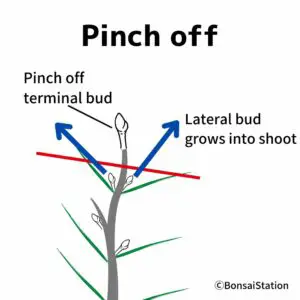
Pinch off

New ramification
Pruning and pinching (tipping) are bonsai techniques that aim to control apical dominance. Pruning involves cutting off a part of branches while pinching involves cutting off the tip of the terminal bud.
Apical dominance and crown shape
While apical dominance is a common phenomenon among bonsai species, the strength exhibited in the trees is different.
There are species that exhibit strong apical dominance, such as pine trees and most conifers. In these species, the trunk or main stem grows more than the other branches and the branches attached to the trunk grow more than those attached to branches.
This orderly growth habit results in a pyramidical tree shape.
On the other hand, some species like deciduous trees do not display strong apical dominance. They tend to exhibit less structured growth, with many shoots growing at the same rate and forming multiple branches.
This is why deciduous trees like Japanese maple have large, spreading crowns rather than pointy top.
Root growth
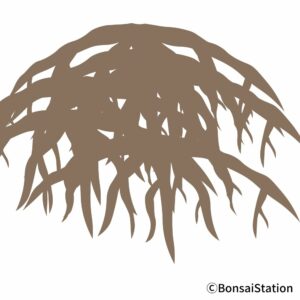
The root systems of trees consist of long-lived, large roots and many short-lived small and fine roots. Fine roots are especially important because they are responsible for most water and nutrient uptake and not large roots.
Fine roots have a rapid turnover rate and may turn over several times a year. The growth of fine roots varies greatly with tree species, tree age, attacks by insects and fungi, and environmental conditions.
The growth of roots happens in two ways: (1) the existing roots getting longer and (2) new lateral roots starting to grow, which then get longer.
In places with four seasons, roots usually start growing earlier in the spring and keep growing later in the fall than the shoots of the same tree. Different trees have different patterns of root growth and the growth of roots does not always coincides with that of shoots.
Some trees have roots that keep growing for a long time after winter buds are ready, while others stop growing sooner. Some stop growing roots during summer and resume in fall while others continue to grow throughout the growing season. Some grow most vigorously in spring while others in summer or fall.
That said, roots do not usually grow during the coldest months in winter even those of coniferous trees and all roots start to grow at the beginning of spring.
This is why bonsai repotting is best done at the very end of winter or the beginning of spring before buds break. After repotting, trees soon start to grow and have a full growing season to recover from the stress of repotting and establish a new root system.
Bonsai Tree Growth speed
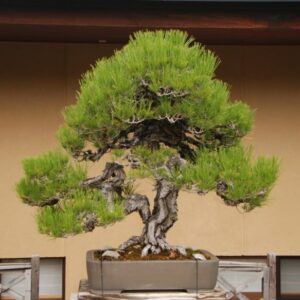
Growth speed varies greatly from one tree species to another. Besides tree age and environmental factors such as water, light, nutrients and temperature, genetics play a large role in how fast trees can grow. Even within the same species, different cultivars may have different growth rates.
Fast-growing species tend to have higher rates of photosynthesis and are more efficient in using energy for growth, maintenance, and water uptake. This means that they achieve a higher growth rate compared to slow-growing species under the same conditions.
Another factor that influences the tree growth rate is leaf area. Generally, the same species of trees with more leaf area grow faster than those with less leaf area because they can produce more energy through photosynthesis.
If you want certain branches or trunks to thicken, you just let them grow so that more energy can be produced with more leaves attached. Or you can prune some branches a bit shorter to divert energy to other parts of the tree that you want to grow.
If you want your tree to grow slower, on the other hand, defoliation of part or full leaves decelerates the tree’s growth.
The following is a list of bonsai species categorized by growth speed: fast or slow. Please note that “fast” and “slow” here is a relative term among these bonsai species and does not mean they are classified as fast or slow in other measurements like how fast they can grow in a year.
Fast-growing bonsai species
- Japanese black pine
- Japanese red pine
- Japanese cedar
- Hinoki cypress
- Chinese juniper (Shimpaku juniper)
- Jack pine
- Japanese maple
- Gingko
- Sawtooth Oak
- Zelkova
- Cherry blossom
- Japanese apricot
- Wisteria
- Azalea (and Satsuki azalea)
Slow-growing bonsai species
- Japanese white pine
- Ezo spruce
- Japanese yew
- Fir
- Boxwood
- Chinese elm
- Camellia



